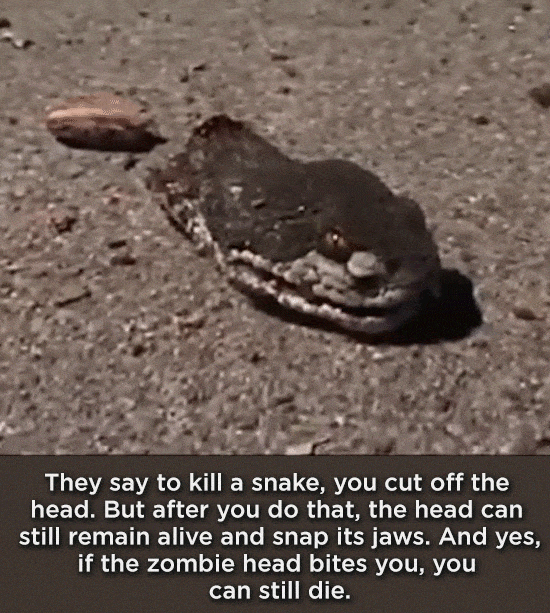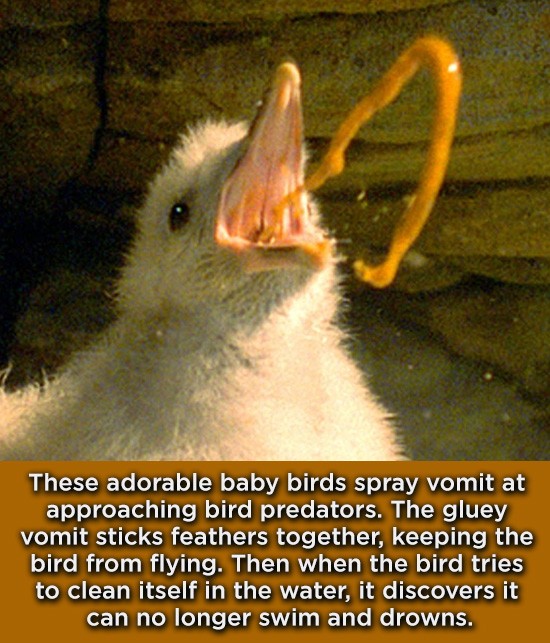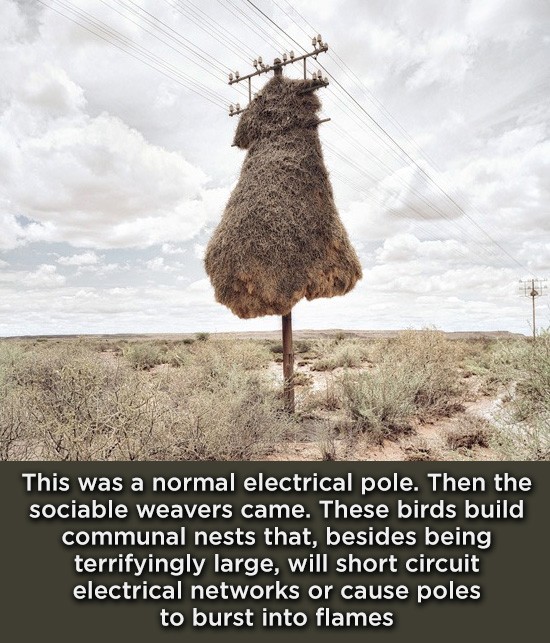55 Animals With Unreal Powers

The internet is very happy to inform you that animals are good at looking adorable, falling asleep in your lap, and courageously learning to climb stairs. But we've found that animals are capable of a whole lot of things you'd never expect. Prepare to be amazed, disgusted, and occasionally terrified ...
1. Newts
The Spanish ribbed newt has ribs that poke out through its skin. When a predator approaches, it cries out poison tears, coating the spikes, then stabs the attacker with the deadly rib protrusions.
Don't Miss
2. Elephants
Elephants don't seem all that stealthy, but they can communicate using an infrasonic murmur we can't hear. The sound goes down their body, out their legs, and across the ground to other elephants 20 miles away.
3. Sea Cucumbers
A sea cucumber can -- voluntarily -- transform itself into liquid. Then, it can turn this liquid back into a full body. Scientists are trying to find how to replicate this process, and we can only hope they will fail.
4. Foxes
Foxes seem to use the Earth's magnetic field to decide from which direction to strike their prey. This is weird but downright reasonable compared to dogs, who appear to use the same thing to decide which way to face when they poop.
5. Monarch Butterflies
Every year, millions of butterflies migrate south to a patch in Mexico, just 10 acres in size. It's amazing that their instincts make them do this, but it's absolutely incredible when you realize individual butterflies can't live long enough for the full journey. Each migration spans generations.
6. Rattlesnakes

7. Whales
You might already know about whale songs. But the more scientists study whales, the more these songs seem like pop songs. They aren't just calling out to each other like birds -- individuals compose new songs, which travel across cultures and across oceans depending on how much other whales like them.
8. Starfish
Ophiocoma wendtii has crystals throughout its skin, linked with nerve bundles that work just like optic cables. Put it all together, and its entire body is a giant eye. This almost makes up for the fact that it has to eat using its anus.
9. Hunting Spiders
Sometimes, spiders spin their webs collectively. Take the Agelena consociata. Sometimes, 1,500 spiders will come together and build a giant web 13 feet tall.
10. Crazy Ants
Beware of crazy ants. They're attracted to electricity, so they invade outlets, appliances, and even NASA computers. They do die when they get electrocuted. But then their corpses emit pheromones that summon even more crazy ants.
11. Jewel Beetles
Jewel beetles can sense fire. And, sure, you can sense fire too, once it's close enough to burn you, but these beetles have been known to travel 50 miles to approach a fire ... so they can mate in a burned tree that now lacks defense mechanisms.
12. Toadfish
A type of toadfish called a plainfin midshipman emits a hum that drives people who live on the coast nuts. Some people have even killed themselves over the hum. And the reason for the hum? The fish are really horny.
13. Fulmars

14. Turtles
If you yank a heart out of a turtle's body (note: don't do this), it'll keep beating. Not just for a few seconds, like the heart of a victim you sacrificed in a temple, but for half an hour. That's because turtles are adapted for low-oxygen environments, which lets them dive for dozens of hours without breathing.
15. More Turtles
Turtles famously live a long time. But what scientists only recently discovered what that "old" (150-year-old) turtles are biologically indistinguishable from ones that are just teenagers. They don't seem to age at all.
16. Hammerhead Sharks
Hammerheads have a special type of receptors called the ampullae of Lorenzini. These sense electricity ... even a tiny amount of electricity. Meaning, even half a billionth of a volt, less than a trillionth of what it needs to find you hiding in an ocean bunker.
17. Clams
Clams are such simple creatures that you might guess they live around as long as insects. Actually, they live for centuries. We found one that's 405 years old and assume that others are even older.
18. Caterpillars
Woolly bear caterpillars seek out a specific type of poison alkaloid to kill parasites inside them. If they ate more of this insecticide, it would kill them too, but they always manage to get the dosage right.
19. Humpback Whales
When humpbacks see a school of fish they want to eat, they group together and release bubbles in unison. These trap the fish -- humpback whales fish using nets. Then they sing, which sonically stuns the prey.
20. Geckos

21. Frogs
Remove a frog's brain, and flip the animal upside down, and it'll jump back upright. Pinch it, and it'll hop away. Drop it in water, and it'll swim. Brains are overrated.
22. Parrots
Parrots name their babies. There are just a handful of species that do this, as far as we know. Primates and dolphins (and humans, often), but it turns out parrots and crows do too.
23. Dogs
In Thailand, stray dogs wear vests with hidden security cameras. Every time the dog barks, the camera activates, and a human elsewhere can monitor it to spot crime.
24. Chimpanzees
Chimps make their own dolls from sticks and vines. Girl chimps play with them, pretending they're babies and building dollhouses for them. Boy chimps do, too, though only after witnessing their mothers with actual baby chimps.
25. Termites
Underground, each termite colony sprawls for acres. Aboveground, the mound can rise to 25 feet (the equivalent of a human-size termite making a mound a mile tall). Inside? It has air conditioning and central heating.
26. Gophers
Gophers are bigger than termites, of course, so their networks of tunnels span hundreds of acres. They build levees at entrances to prevent flooding and staff watchtowers with guards to scout for danger.
27. Grizzlies

28. Hairy Frogs
Hairy frogs will shank you. Nice! The source of this blade? Their own skeleton. They break a bone in their hind feet, rip it out through their skin, then stab their attacker.
29. Hornets
The Oriental Hornet is solar-powered. It makes electricity out of UV-rays, uses some of that energy to power its wings, and puts the rest toward air conditioning.
30. Dana Octopus Squids
These squids flash lights to stun their prey. They set off a dizzying disco strobe light routine -- dana octopus squids use flashbang grenades.
31. Cats
Cats don't just purr when they're happy. They also purr when in pain. It turns out they use this to heal themselves because vibrations at that frequency promote bone density. A cat purring can even help you heal.
32. Goats
Goats aren't known for being friendly, but you can get goats to caddy for you while you golf. This works especially well if you're on a course that's too steep for carts.
33. Trout
When a female brown trout considers her mate inadequate, she fakes a climax (which isn't necessarily an orgasm in the case of fish but does involve the release of eggs). The male, too excited to stop, releases his own load uselessly, and the female gets to save her eggs for someone fitter.
34. Beavers

35. Rats
A lot of lab tests are performed on rats, but sometimes, rats are the ones doing the tests. Rats use their noses to detect tuberculosis in human blood samples. A rat can test 100 samples in 20 minutes (versus four days using traditional testing).
36. Birds
Bird chirping isn't a language, exactly. But it does have grammar, and when one bird gets that grammar wrong, others will jump in to correct them.
37. Bobtail Squids
The bobtail squid grabs glowing bacteria and uses them as headlights. This does not make it more visible underwater, as you might think. Instead, that makes it less visible because a bright object forms less of a silhouette against a brighter shallower background.
38. Lobsters
Lobsters might just be immortal. Okay, you can kill one without much trouble, but if you don't, it doesn't seem like they ever age. They just keep growing bigger, and stronger, and more fertile with each passing decade.
39. Labradors
Dogs can smell diseases in humans, which is cool. They can also smell diseases in bees, which is weirder. The disease is called American foulbrood and kills whole honeybee colonies, which is why beekeepers send in the sniffer dog ... who wears a special suit to keep from getting stung.
40. Proboscis Monkeys
The proboscis monkey is named after its nose, but it may as well have been named after its other most obvious feature: its skinny, flaming-red erection. When an opponent approaches, the monkey spreads its legs wide and brandishes its boner. The opponent quickly flees, which is understandable.
41. Dragonflies

42. Fruit Flies
When a female fruit fly loses its head, it'll go on living just fine for a few days. It can even react to light, thanks to eyes located in its kidneys. And male flies will still want sex, but the female will reject him, now lacking the antenna to hear his love song.
43. Ferrets
When people can't squeeze into hard-to-reach areas, they send in ferrets. Ferrets can carry wires and cables, and they've been responsible for tech at some of Britain's highest-profile events, including Charles and Diana's wedding and the Queen's Silver Jubilee.
44. Wood Frogs
If you freeze solid, you'll die, of course. Freeze a wood frog solid, so all brain activity ceases, and it's dead by all known measures? It'll thaw out in the spring and be alive and hopping once again.
45. Wasps
Mud dauber wasps use mud and their own puke to create prisons. They paralyze spiders and put them in cells, three to a room. The live spiders stay fresh, so when wasp eggs hatch, larvae can feed on the prisoners.
46. Spiders
A female spider might rip the male's penis off during sex. But that doesn't stop the severed spider penis, which continues moving and pumping out semen -- more efficiently than before being disembodied, actually.
47. Sponges
Sea sponges are so primitive that they barely qualify as animals at all. But they are animals -- really, really old animals. Glass sponges can live for 15,000 years. Entire populations of animals can get swallowed by a sponge and evolve without ever escaping.
48. Weavers

49. Monkeys
It took a while for humans to figure out birth control. Monkeys are already on the way there. They eat plants that boost estrogen levels, which reduces the fertility of too-fertile monkeys -- while other monkeys, who aren't fertile enough, eat different plants that appear to boost fertility.
50. Mantis Shrimp
A mantis shrimp can see everything you can. It can also see heat. And it can see UV radiation. It can see polarized light, with the sort of precision that we need thousand-dollar equipment to match.
51. Donkeys
If you had to imagine a fight between a donkey and a bunch of coyotes, you'd probably put your money on the coyotes. And you would lose. Ranchers now use donkeys to keep coyotes away, and when donkeys can't do the job, llamas can.
52. Hoopoes
This hoopoe is the national bird of Israel. Maybe they should choose a different bird, considering the hoopoe's best-known ability is its tendency to turn around and squeeze feces into its opponent's eye and then spray itself with anal secretions to make itself unappetizing.
53. Chickens
Hens are able to expel the semen of any rooster who inseminates her without being high enough on the pecking order. That even happens when a series of roosters mates with the hen in turn, whether the undesirable male steps in first, last, or anywhere in between.
54. Turkey Vultures
The turkey has a fine peace offering to offer to potential predators: It vomits in front of them. This offers something for them to eat, other than the turkey vulture. Of course, vultures eat rotting carcasses, so the vomit is filled with decayed meat and maggots.
55. Crocodiles
